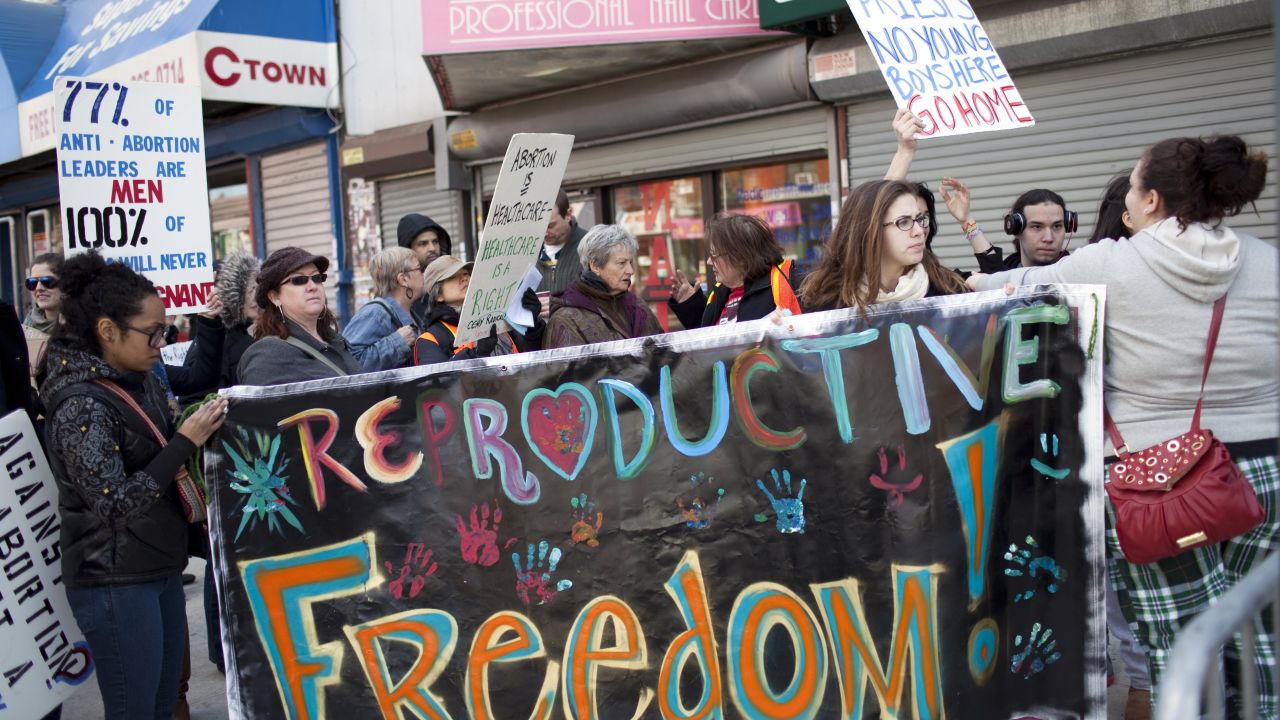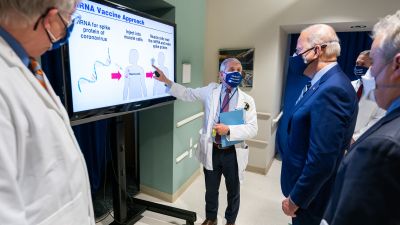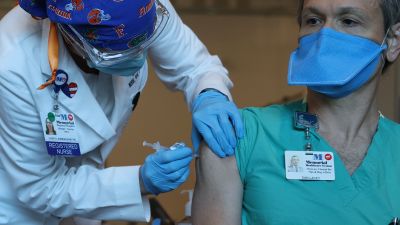
Supporters of women's right to have an abortion line the sidewalk outside the Dr. Emily Women's Health Center on March 12, 2011, in Bronx, New York. Anti-abortion activists and clergy had been targeting the South Bronx clinic for two and a half years. (Photo by Robert Nickelsberg/Getty Images)
If the anti-abortion movement had its way, no woman would be allowed an abortion — turning back the clock a half-century and then some. The stark reality of what is at stake is that the US is only one or two Supreme Court justice swaps away from that.
Even now, between full access and an outright ban lies a vastly unequal set of options for women across the United States. Depending on where they live, how old they are, what type of health insurance they have, or how far along they are in their pregnancy, women seeking abortions have very different experiences. In 26 states, abortion opponents have been constructing elaborate and ever more creative restrictions to do everything but make abortion illegal.
US Rep. Henry Hyde (R-IL) put that particular truth bluntly. “I would certainly like to prevent, if I could legally, anybody having an abortion: a rich woman, a middle-class woman or a poor woman,” he explained. “Unfortunately, the only vehicle available is the … Medicaid bill.” It was 1976, only three years after Roe v. Wade had felled abortion bans across the country, but the period in which abortion was not only legal but normal and accessible proved very small. To this day, the Hyde Amendment blocks federal funds from covering abortion except in very rare circumstances.
But that was just the beginning.
“Since Roe, nearly all of the action has been on the state level,” says Elizabeth Nash, an analyst at the Guttmacher Institute, who counts over 1,000 abortion restrictions on the state level since Roe v. Wade in 1973.
Today, depending on what state you live in, any of the following may be required:
- That doctors falsely tell their patients that abortion causes suicide, cancer or infertility, or even claim that abortion can be reversed, both in defiance or utter absence of evidence.
- That doctors tell their patients that the fetus is “a whole, separate, unique, living human being” and that “the pregnant woman has an existing relationship with that unborn human being and that the relationship enjoys protection under the United States Constitution.”
- That doctors must perform invasive ultrasounds even if there’s no good medical reason.
- That patients must view them or listen to them whether they want to or not.
- That doctors must offer counseling 24 or 48 or 72 hours ahead of time, just to make sure that patient isn’t aborting willy-nilly.
- That doctors must collect elaborate certifications or rebuild their clinics to be hospitals.
- That minors have the right to decide to be parents but not to not be a parent unless they have a judge or parent’s approval.
- That patients must bury their embryos and fetuses to the liking of the legislature, however they feel about it.
What’s more, over a dozen states block abortions after 20 weeks, which is before viability, a legal term that means the baby can survive outside the mother’s womb. The laws are premised on a notion of fetal pain that mainstream health organizations reject. Republicans in Congress and in Ohio have even repeatedly introduced bills that ban abortion at the detection of a fetal heartbeat, or around six weeks, despite being unconstitutional on their face.
Nash says some states have actually run out of ways to restrict abortion, so to keep the momentum going they’re looking to fortify what laws they do have, such as requiring extensive identification documentation like birth certificates for parents signing off on minors’ abortions or notifying parents of their teens’ intentions to terminate even if they go to a judge instead.
Maybe you don’t live in a state that requires any of this. But 57 percent of American women of reproductive age live in states that are considered hostile to abortion rights.
That’s just what’s on paper. In practice, patients may have to walk by a daily gantlet of protesters, who these days are armed with recording devices and social media — or even actual weapons. According to the National Abortion Federation, there have been 7,731 incidents of extreme violence against abortion clinics since Roe, including 11 murders, 26 attempted murders and 42 bombings.
All this was the landscape before Trump became president, before the strategists who crafted these laws at the state level became federal appointees with the power to shape national policy. Charmaine Yoest used to run Americans United for Life, which wrote the playbook on state-level restrictions on abortion; Teresa Manning was a lobbyist for the National Right to Life Committee; Scott Lloyd repeatedly crusaded against publicly funded contraception; Matthew Bowman made his name at Alliance Defending Freedom, a key legal player defending anti-abortion laws and poking holes in contraceptive access. These days, all four are top officials at the Department of Health and Human Services, the agency that administers women’s health services, including contraception. In recent months, the agency has been busy blocking undocumented minors from accessing abortion, pressuring them not to have the procedure and dragging them to crisis pregnancy centers.
Meanwhile, many of the brakes on state-level restrictions came from federal courts, and President Trump has been stacking federal courts with sympathetic judges, each with a lifetime appointment, at nearly unprecedented speed.
It all feels impossibly bleak to supporters of abortion rights. But there are pockets of fierce resistance. For nearly every law creating a roadblock to access, there is a lawyer from the ACLU or the Center for Reproductive Rights or Planned Parenthood filing suit. For all the waffling politicians, there is a NARAL or ReproAction or SisterSong holding them accountable. For all the funding bans, there are independently organized abortion funds, doling out what money they can, one patient at a time.
For all the dwindling clinics and barriers to access them, and for all the stigma in the world and misinformation online, there’s even a 21st century version of the pre-Roe collectives that surreptitiously counseled women on accessing abortion. In April, the international group Women Help Women launched the program “Self-managed Abortion; Safe and Supported” (SASS) to offer women information on managing their own abortions through pills separately accessed online. Its founders write: “We believe that every woman should have complete control over her own reproductive choices, including the ability to end a pregnancy safely on her own terms.”
The abortion clinics fighting to stay open say they want much of the same things for their patients. Outside their walls, though, is a battlefield.





